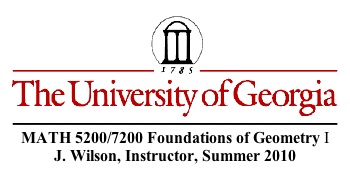

Axiom A.1 Lines, planes, and space are sets of points. Space contains all points.
Axiom A.2 Any two distinct points are on exactly one line. Every line contains at least two points.
Axiom A.3 Any three noncollinear points are on exactly one plane. Each plane contains at least three noncollinear points.
Axiom A.4 If two points of a line are in a plane, then the entire line is in the plane.
Axiom A.5 In space, if two planes have a point in common, then the planes have an entire line in common.
Axiom A.6 In space there exist at least four points that are noncoplanar.
Theorem A.1 If two distinct lines intersect, they intersect in exactly one point.
Proof:
Let the two lines be k and l. We are given that they intersect, assume at a point P on both lines. Assume that the two lines also intersect at Q and we will look for a contradiction.
By Axiom A.2 there is a unique line through P and Q. Therefore k and l are same line. This contradicts the hypothesis in our theorem that the two lines are distinct. Therefore the existence of a second point Q on both lines must be rejected.
Now Solve This A.1
Problem 1: What is the maximum number of intersection points determined by n lines in the same plane?
Problem 2: What is the maximum number of lines determined by n points? Does it matter if the points are in the same plane?
GSP file for solution suggestions and additional Problems.
Example A.1
Now Solve This A.2
Libeskind poses this situation:
Discuss how you would respond to this student?
Note: a) the student knows the result is wrong
b) the student wants to understand "why"
c) the student wants to know if there is a way to use her 'approach'
Axiom A.7. The Ruler Postulate. The points on a line can be put in one-to-one correspondence with the real numbers.
Axiom A.8. The Plane-Separation Axiom. Each line in a plane separates all of the points not on the line into two nonempty sets, called the half-planes, with the following properties:
1. The half planes are disjoint (have not point in common) convex sets.
2. If P is in one half plane and Q is in the other half plane, the segment PQ intersects the line that separates the plane.
Theorem A.2 Pasch's Axiom. If a line intersects a side of a triangle and does not intersect any of the vertices, it also intersects another side of the triangle.
Theorem A.3 was 'left as an exercise for you' but it did not make it into the Problem Set. Notice that if is an 'if and only if' theorem.
PROOF? Try this one:
Axiom A.9 The Angle Measurement Axiom.
The is a real number betweem 0 and 180 that corresponds to every angle BAC. The number 180 corresponds to a straight line.
Axiom A.10 The Angle Construction Postulate
Let AB be a ray on the edge of a half plane. For every real number r, 0 < r < 180, there is exactly one ray, with C in the half plane, such that angle CAB has a measure of r.
Axiom A.11 The Angle Addition Postulate.
Undefined terms.
Point
Line
Plane
Set
Belongs to
Is an element of
A few defined terms
parallel
skew
convex set
Ray
Angle
triangle
sides
vertices
segment
midpoint